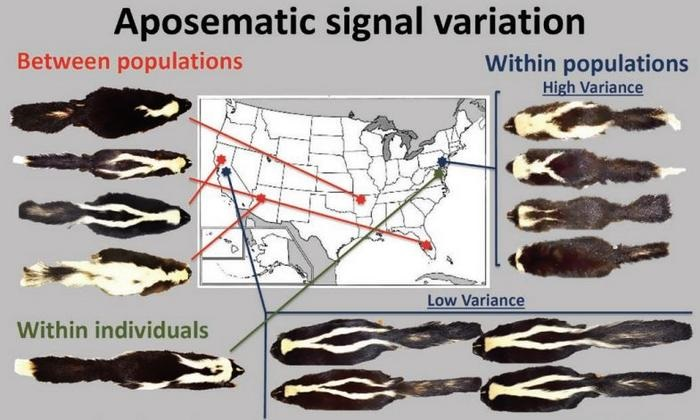Picture a skunk. Bit of an odd request, but go with us here. You’re probably seeing the common striped skunk: a small, furry mammal with a pattern of white stripes along its black fur. As it turns out, though, those characteristic stripes are far from universal. There’s a huge amount of variation in skunk markings all across the North American continent, and the authors of a new study think they’ve hit on the reason why.
Researcher Hannah Walker, from the University of Montana, used almost 750 photographs of museum specimens to map the distributions of skunks with different coat colors across North America. The large sample size meant that all of the 13 subspecies of the striped skunk, Mephitis mephitis, were represented in the data.
Against this data, the team plotted various factors that they thought could be contributing to the variation in coat patterns. One factor began to emerge as a strong contender: the presence or absence of predators.

Some examples of the variety of skunk coat markings, showing where these are distributed in North America.
Image credit: Prof Tim Caro
A skunk’s iconic coloring, Chanel-esque though it may be, is not for decoration. It’s a signal to predators to stay away, lest they get a faceful of toxic anal spray.
“Warning coloration is an antipredator defence whereby a conspicuous signal advertises the ability of prey to escape predation, often because it is toxic or has spines or is pugnacious,” said co-author Professor Tim Caro of the University of Bristol in a statement.
“Usually predators have to learn the significance of this signal and so it is predicted that warning colouration will look very similar across prey individuals of the same, as well as perhaps different, prey species to be an effective education tool. Yet some warningly coloured prey show rather different advertisements even within the same species.”
Indeed, in areas where the skunks’ territory overlapped with comparatively few mammalian predators, variation in fur color was seen even within litters of kits from the same family. However, skunks in regions with lots of dangerous predators displayed far more uniform markings.
Interestingly, this effect was less evident when the team only considered predatory birds, like great horned owls. This could be because birds have a poorer sense of smell than mammals, and thus are less deterred by the stinky spray that the stripes are warning against.
The evolutionary process that is driving the loss of stripes in some skunks is called relaxed selection. It happens when selection for an important trait is weakened by changes in the environment – in this case, fewer dangerous mammals sniffing around. Simply put, it’s just less important for skunks to have a uniform warning signal when there aren’t so many potential predators around to see it.
“We now know why not all skunks look alike, and perhaps why members of other warningly coloured species look different from each other,” summarized Professor Caro.
The next step is to see whether similar trends occur between other species of skunks in North America with different coat patterns (not to mention incredible gymnastics skills). As Professor Caro explained, “If relaxed selection operates within species, it should do so across prey species too. More broadly, this study provides another brick in the wall of explaining the evolution of coloration in nature.”
The study is published in the journal Evolution.
Source Link: Why Some Skunks Are Losing Their Stripes